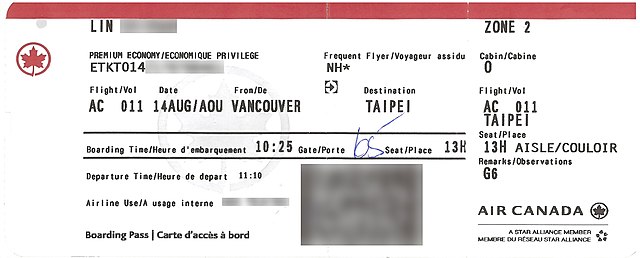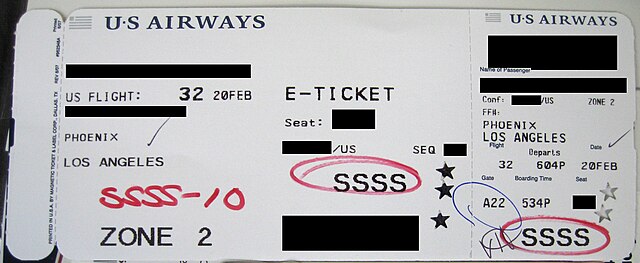A boarding pass or boarding card is a document provided by an airline during airport check-in, giving a passenger permission to enter the restricted area of an airport and to board the airplane for a particular flight. At a minimum, it identifies the passenger, the flight number, the date, and scheduled time for departure. A boarding pass may also indicate details of the perks a passenger is entitled to and is thus presented at the entrance of such facilities to show eligibility.
Modern boarding pass for Air Canada. A variety of information relevant to the flight is printed on the pass, including the departure and arrival airports, the passenger's travel class, the flight number and the departure time.
An older, non-computerized Air Transat boarding pass from 2000.
A U.S. Airways boarding pass, featuring the initials SSSS, indicating that the passenger holding the pass has been selected for a Secondary Security Screening Selection check.
A handwritten Air Canada boarding pass from 1979
Airport check-in is the process whereby an airline approves airplane passengers to board an airplane for a flight. Airlines typically use service counters found at airports for this process, and the check-in is normally handled by an airline itself or a handling agent working on behalf of an airline. Passengers usually hand over any baggage that they do not wish or are not allowed to carry in the aircraft's cabin and receive a boarding pass before they can proceed to board their aircraft.
Check-in counters of Thai Airways International at Suvarnabhumi Airport, Bangkok
Aer Lingus self-check-in at Dublin Airport
Panorama of a modern airport check-in hall at Ezeiza International Airport in Buenos Aires
Check-in Hall A at Leeds Bradford International Airport








